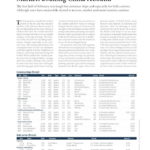The first half of February was tough for container ships and especially for bulk carriers. Although rates have meanwhile started to recover, market sentiment remains cautious
The first quarter is usually the weakest period in the dry and the container markets, with February the low-point[ds_preview] of the year depending on the exact timing of Chinese New Year. No wonder then that there is so much red-ink across our market compass on the opposite page. The intensity of the rate falls was exceeding expectations, though, especially in the capesize sector. The tailings dam disaster and consequent losses in iron ore shipments ex Brazil coupled with the withdrawal of Chinese chartering demand during the Golden Week melded into a kind of perfect storm for the largest bulkers. Average spot time charter earnings were slashed by more than half, with rates still fragile and softening again at the time of writing. A return of Australian iron ore miners to the market and short waves of tonnage fixing for Brazil cargoes to China was not enough to turn the market around and lift average rates above operating costs again. Brokers cited a persistent lack of cargoes in the North Atlantic and a rise in redeliveries of period vessels onto the market as factors for the prolonged slump.
The panamax and handy bulk segments showed more encouraging signs as tonnage demand gathered momentum once more, albeit partly restricted to certain areas. Average time charter earnings for panamaxes were still down by around one fifth compared with end of January but the trend was pointing upwards again, led by resurging demand in the Pacific region. There were growing reports of North Pacific grain business and minerals ex Indonesia and Australia, often for discharge in India, which put rates on the ascent. By contrast, the Atlantic took longer to see any material increase in demand which meant that the gap in earnings showed no signs of narrowing until calendar week 8. Transatlantic trips were rated at just half the level (2,500-3,500$/d) reported for transpacific round trips. US soyabean liftings to China are still missing as base cargo for panamaxes in the Atlantic and the outlook remains uncertain. Following the temporary trade truce in December, the volume of U.S. soya beans inspected for export and ready for shipping surged from just around 25,000t in December to 1.2mill. t in January. However, time is running up fast for the 1 March deadline and the US and China are not expected to reach an agreement by then, putting a big question mark over the near-term development of soya bean shipments. Shipowners may hope that the new harvest in Brazil will translate into large replacement volume for China over the coming months which would stimulate panamax demand. The problem, though, is that Chinese demand is hard to read at this stage as the fast spreading of African swine fever and falls in the hog population may result in reduced demand for animal feed.
The spot market for supramax bulkers performs the strongest right now, logging the only month-on-month gain among all size classes and also the highest spot earnings in absolute terms. The pulse of trade was quickening right after Chinese New Year in both basins. The biggest jumps were recorded in the US Gulf with fixtures for fronthaul business (petcoke to Japan) surging to over 20,000$/d. The Black Sea was also getting vibrant again with plenty of fresh grain stems.
Rates in the North Pacific and in southeast Asia firmed up to 7,500-8,000$/d, assisted by a surge in Chinese steel cargoes for Asian and long-haul destinations which absorbed quite a bit of tonnage.
In the handysize segment, the Atlantic showed rapidly improving levels as fresh cargoes emerged in the Black Sea, the US Gulf and on the East Coast of South America, with larger handies fixing 7,000’s (Black Sea) up to around 9,500$/d (US Gulf). Only north continent Europe was still quiet. The tone in the Pacific was gradually firmer but still lagging some way behind the Atlantic, with round trips typically concluded in the 6,000-7,000$/d range.
Of note, the mpp market also seems to have been affected by the earlier downturn in dry cargo rates around Chinese New Year. The Toepfer Multipurpose Index for 12,500 dwt F class ships basis 6-12 month periods dropped from 7,593 to 7,457$/day in February. Larger 28,000-32,000 dwt mpp units were reportedly fixed in the Far East at lower levels in the 7,500-9,000$/d range.
Contrary to the deepsea dry bulk market, the European shortsea trades are still caught in a slight downward spiral, with all three benchmark indices in our market compass down month-on-month. The anticipated recovery did not materialise during February and spot tonnage lists were still outweighing cargo offers in virtually all regions, brokers said.
Big container vessels sold out
The container ship charter market finally seems to have bottomed out, the New ConTex was down just 1.0% month-on-month but with a steady tendency at the time of writing. The highlight of the month was continued brisk demand for the largest gearless vessels in excess of 8,000TEU which resulted in gains of 2,000-3,000$ over January levels to 18,000-19,000$/d. The driver was MSC with a spate of extensions and fixtures of vessels, followed by Chinese charterer. The smaller 5,500-6,500TEU segment registered improvements as well, with levels in the Atlantic soaring to high 12,000’s $/d versus 9,000-10,000$/d in Asia. Little by little, the firmer tone began to spread into certain smaller classes such as the widebeam panamax segment with fixtures reportedly up in last done at high 14,000’s $/d. Gearless 2,700/2,800TEU ships got hoovered up quickly in the Mediterranean at slightly higher rates in the low 9,000’s while standard geared 1,700TEU ships in Asia recorded a slight increase in the low 7,000’s $/d after a long drought. In the feeder sector, market conditions have significantly improved in North Europe and the Mediterranean. Rate levels went up by several hundred dollars or euros for various vessel classes.


















